Praxis Precision Medicines general counsel sells $4.8m in shares
Introduction & Market Context
MKS Instruments Inc (NASDAQ:MKSI) presented its first quarter 2025 financial results on May 8, revealing a strong performance despite mixed market conditions. The company’s stock, which closed at $74.30 on May 7, showed signs of recovery with a 3.9% increase in premarket trading, reflecting positive investor sentiment following the results.
The presentation highlighted MKS’s ability to capitalize on strength in semiconductor and electronics markets while navigating challenges in industrial segments. This performance comes after a period of stock volatility, with MKSI trading significantly below its 52-week high of $147.40.
Quarterly Performance Highlights
MKS reported revenue of $936 million for Q1 2025, exceeding the high end of its guidance range. The company delivered a non-GAAP gross margin of 47.4% and adjusted EBITDA of $236 million, representing 25.2% of revenue. Non-GAAP net earnings per diluted share reached $1.71, showing the company’s continued profitability despite market headwinds.
"We had a strong start to the year with revenue across all end markets at the high end of our guidance," the company noted in its presentation, emphasizing improved gross margins and increased non-GAAP earnings per share and free cash flow.
As shown in the following financial results summary:
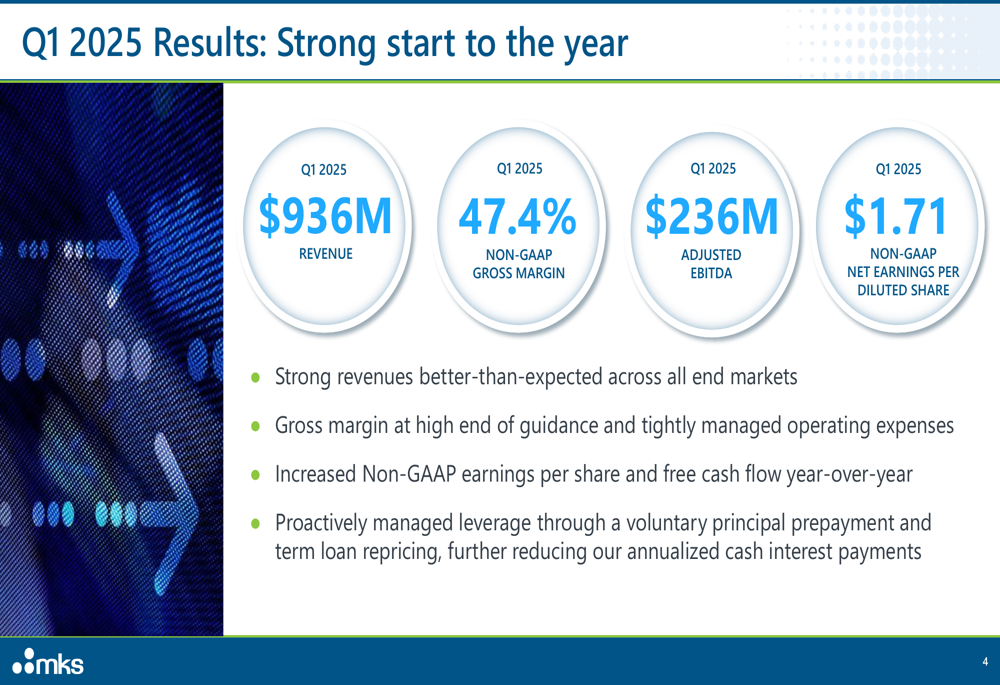
The company’s performance demonstrates its resilience in navigating diverse market conditions, with particular strength in semiconductor-related segments offsetting weakness in industrial applications.
Segment Analysis
MKS’s business performance varied significantly across its three main segments, reflecting different market dynamics:
Semiconductor Segment
The Semiconductor segment delivered $413 million in revenue, increasing 3% sequentially and 18% year-over-year (20% excluding foreign exchange impacts). This growth was driven by increased demand across NAND, DRAM, and Logic/Foundry applications, with the company noting a normalization of NAND customer inventories. For Q2 2025, MKS expects semiconductor revenue to remain relatively flat at $415 million (±$15 million).
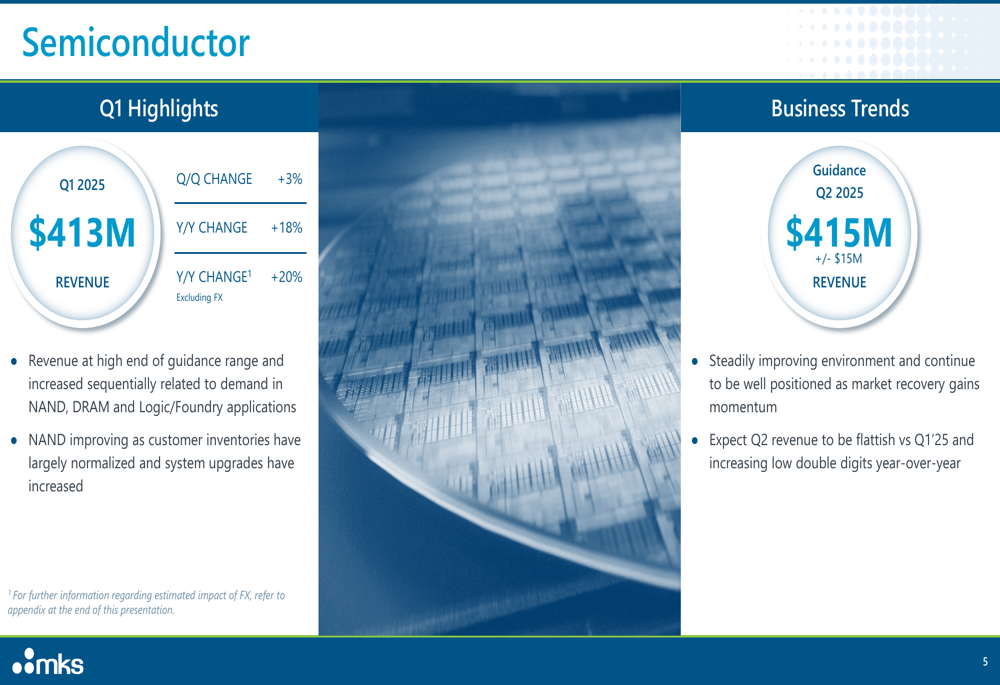
Electronics & Packaging (NYSE:PKG) Segment
The Electronics & Packaging segment generated $253 million in revenue, flat sequentially but up 22% year-over-year (26% excluding FX and palladium impacts). The company highlighted strong performance in flexible PCB drilling and chemistry equipment sales, with continued momentum in orders for chemistry equipment solutions related to AI applications.
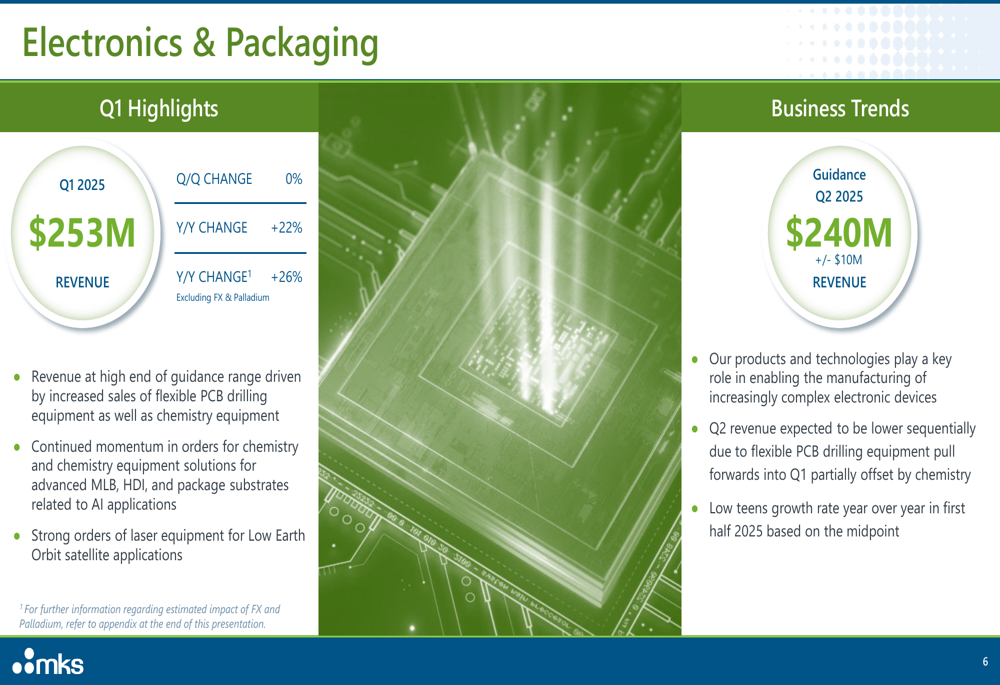
Specialty Industrial Segment
In contrast to the other segments, the Specialty Industrial segment showed weakness with revenue of $270 million, down 4% sequentially and 13% year-over-year. This decline reflected broader industrial market softness, particularly in automotive applications. The company expects this segment to remain challenged in Q2 2025, with guidance of $270 million (±$15 million).
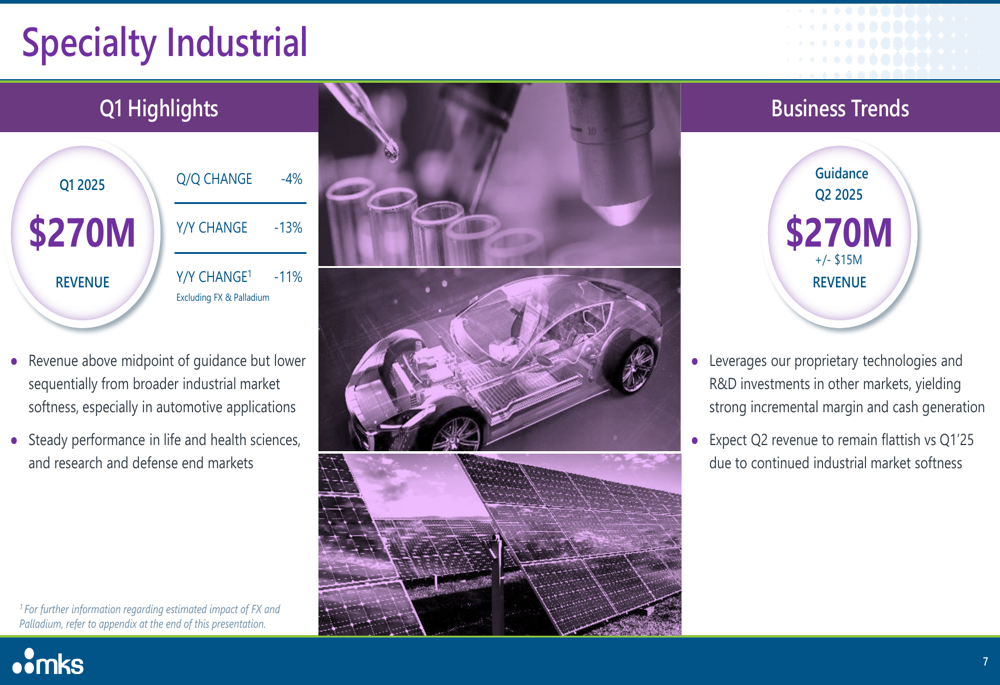
The following chart illustrates the revenue distribution across MKS’s three business segments, highlighting the increasing importance of the Semiconductor segment, which now represents 44% of total revenue:
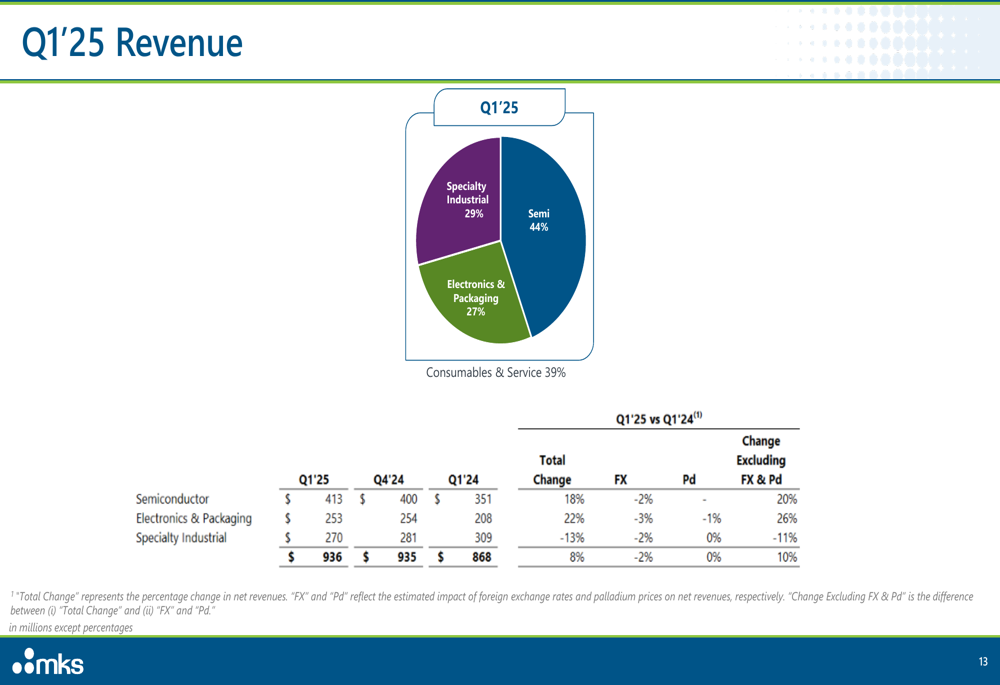
Financial Position & Cash Flow
MKS demonstrated strong financial management in Q1 2025, generating $123 million in free cash flow and maintaining a liquidity position of approximately $1.3 billion. The company continued its capital return program, repurchasing about 500,000 shares and issuing a cash dividend of $15 million ($0.22 per share).
The company’s balance sheet showed total assets of $8.56 billion and debt principal of $4.56 billion, resulting in a net leverage ratio of 4.2x. This represents a continued focus on debt management, which executives had previously identified as a top priority.
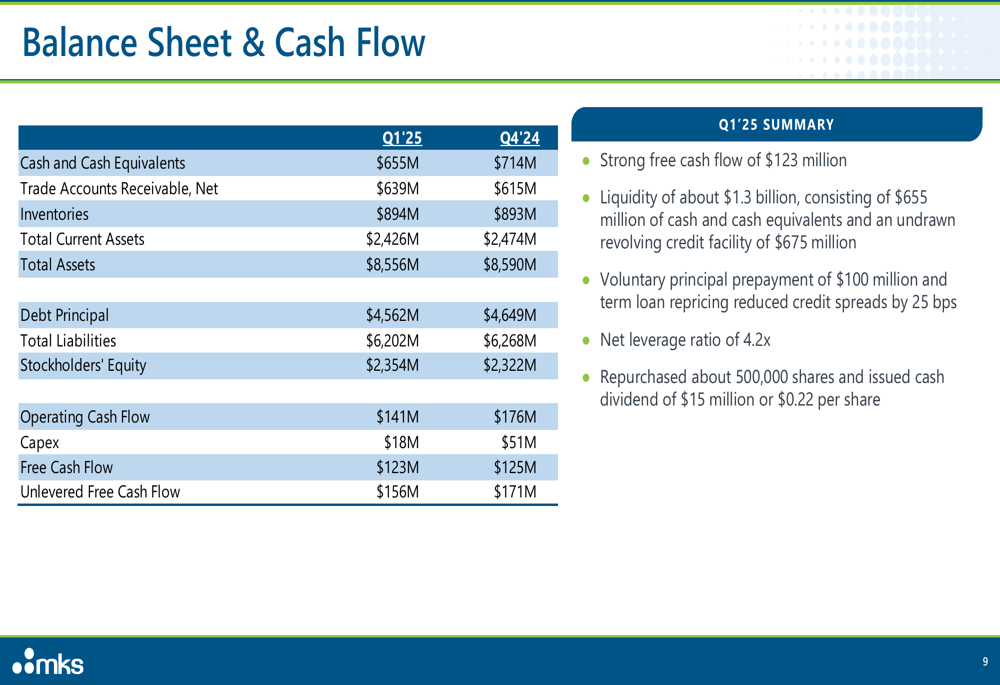
Forward Guidance
Looking ahead to Q2 2025, MKS provided guidance reflecting cautious optimism amid mixed market conditions. The company expects revenue of $925 million (±$40 million), with a non-GAAP gross margin of 46.5% (±100 basis points) and non-GAAP earnings per diluted share of $1.56 (±$0.28).
The guidance incorporates near-term tariff costs estimated to impact gross margin by up to 100 basis points, though management emphasized they are "remaining agile and optimizing performance through cost mitigation strategies."

This outlook suggests a slight sequential decline in revenue and earnings compared to Q1, primarily due to expected weakness in the Electronics & Packaging segment and continued challenges in industrial markets. However, the company’s semiconductor business is expected to remain stable.
Strategic Initiatives
MKS emphasized its strategic positioning for long-term growth despite near-term challenges. The company highlighted its proven track record of managing through uncertainty and its position as a key provider of enabling technologies with strong customer relationships.
The presentation underscored continued momentum in orders for chemistry equipment solutions for advanced MLB, HDI, and package substrates related to AI applications, suggesting the company is well-positioned to benefit from ongoing investments in artificial intelligence infrastructure.
Management also noted its proactive approach to leverage management, which has reduced cash interest payments and strengthened the company’s financial flexibility. This aligns with previous statements from executives about prioritizing debt reduction while continuing to invest in growth opportunities.
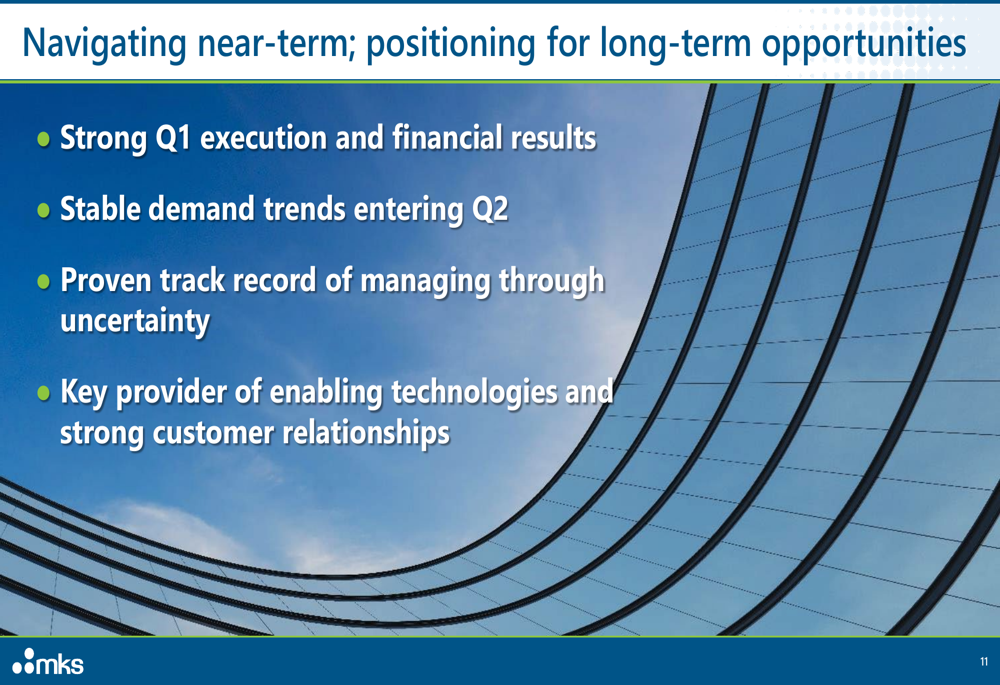
Conclusion
MKS Instruments’ Q1 2025 results demonstrate the company’s ability to navigate a complex market environment, with strength in semiconductor and electronics segments offsetting weakness in industrial applications. While challenges remain, particularly related to tariffs and industrial market softness, the company’s strong cash flow generation and strategic focus on high-growth areas like AI-related applications provide a foundation for continued performance.
As the company moves forward, investors will likely focus on the pace of recovery in industrial markets, the sustainability of semiconductor growth, and MKS’s progress in reducing its leverage ratio while maintaining investments in key growth initiatives.
Full presentation:
This article was generated with the support of AI and reviewed by an editor. For more information see our T&C.
